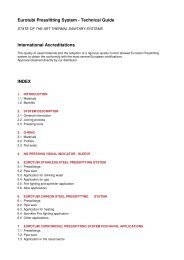corrosion of stainless steel - Damstahl
corrosion of stainless steel - Damstahl
corrosion of stainless steel - Damstahl
Create successful ePaper yourself
Turn your PDF publications into a flip-book with our unique Google optimized e-Paper software.
Chapter 6 - Corrosion <strong>of</strong> Stainless Steel<br />
Figure 6.9:<br />
Pitting <strong>corrosion</strong> in 0.5 mm thick, <strong>stainless</strong> <strong>steel</strong> 4301 sheet after only<br />
a few days immersed in a mixture <strong>of</strong> salt (NaCl) and hydrogenperoxide<br />
(H 2<br />
O 2<br />
). While 99% <strong>of</strong> the surface is completely unaffected, four day's <strong>of</strong><br />
<strong>corrosion</strong> was sufficient to produce penetration. The picture on the right is<br />
a microscope photo <strong>of</strong> the same item; the penetration is right in the center.<br />
6.2.1 Environmental factors in pitting <strong>corrosion</strong><br />
General <strong>corrosion</strong> is, as described above, a type <strong>of</strong> <strong>corrosion</strong> which is always<br />
taking place. Depending on the type <strong>of</strong> acid, pH, temperature, impurities,<br />
type <strong>of</strong> <strong>steel</strong> and other factors, the <strong>corrosion</strong> will take place at a faster or<br />
slower pace, but it will never be zero. Compared to general <strong>corrosion</strong>, pitting<br />
<strong>corrosion</strong> is much more an either/or type <strong>of</strong> <strong>corrosion</strong>. Either things go<br />
incredibly well or else they go very, very badly. There is nothing in between.<br />
The environmental factors influencing the risk <strong>of</strong> pitting <strong>corrosion</strong> for a given<br />
type <strong>of</strong> <strong>stainless</strong> <strong>steel</strong> are usually the following:<br />
Chloride concentration<br />
Temperature<br />
Corrosion potential (type and concentration <strong>of</strong> oxidants, the<br />
cathode reaction)<br />
pH (acidity)<br />
In general the risk <strong>of</strong> pitting <strong>corrosion</strong> rises with increasing chloride<br />
concentration, increasing temperature, increasing <strong>corrosion</strong> potential (cathode<br />
reaction) and decreasing pH (more acidic solution).<br />
6.2.2 Critical Pitting Temperature (CPT)<br />
The interaction between, in particular, chloride concentration and<br />
temperature can be measured using the 'critical pitting temperature' (CPT).<br />
For a certain type <strong>of</strong> <strong>steel</strong> in a certain medium (and at a determined <strong>corrosion</strong><br />
potential), the CPT is the temperature above which pitting <strong>corrosion</strong> will<br />
take place. In practice, CPT is measured by exposing a <strong>steel</strong> electrode to<br />
the medium concerned. The temperature is slowly increased step by step,<br />
and the temperature at which pitting <strong>corrosion</strong> occurs is defined as CPT.<br />
85<br />
RS for alle.indb 85<br />
9/29/2011 12:44:35 PM

















